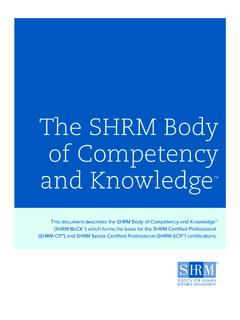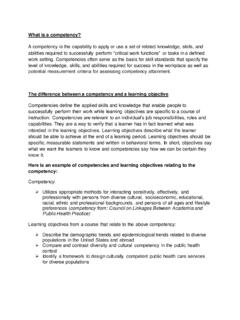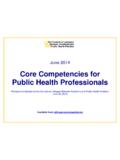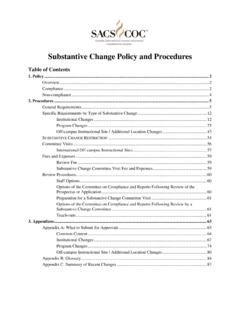Transcription of Informatics Competencies for Every Practicing Nurse ...
1 Overview 1 Informatics Competencies for Every Practicing Nurse : Recommendations from the TIGER Collaborative Overview 2 The TIGER Initiative, an acronym for Technology Informatics Guiding Education Reform, was formed in 2004 to bring together nursing stakeholders to develop a shared vision, strategies, and specific actions for improving nursing practice, education, and the delivery of patient care through the use of health information technology (IT). In 2006, the TIGER Initiative convened a summit of nursing stakeholders to develop, publish, and commit to carrying out the action steps defined within this plan. The Summary Report titled Evidence and Informatics Transforming Nursing: 3-Year Action Steps toward a 10-Year Vision is available on the website at A COLLABORATIVE APPROACH Since 2007, hundreds of volunteers have joined the TIGER Initiative to continue the action steps defined at the Summit.
2 The TIGER Initiative is focused on using Informatics tools, principles, theories and practices to enable nurses to make healthcare safer, more effective, efficient, patient-centered, timely and equitable. This goal can only be achieved if such technologies are integrated transparently into nursing practice and education. Recognizing the demands of an increasingly electronic healthcare environment, nursing education must be redesigned to keep up with the rapidly changing technology environment. Collaborative teams were formed to accelerate the action plan within nine key topic areas. All teams worked on identifying best practices from both education and practice related to their topic, so that this knowledge can be shared with others interested in enhancing the use of information technology capabilities for nurses. Each collaborative team researched their subject with the perspective of What does Every Practicing need to know about this topic?
3 The teams identified resources, references, gaps, and areas that need further development, and provide recommendations for the industry to accelerate the adoption of IT for nursing. The TIGER Initiative builds upon and recognizes the work of organizations, programs, research, and related initiatives in the academic, practice, and government working together towards a common goal. COLLABORATIVE REPORT This report provides the detailed findings and recommendations from the Informatics Competencies Collaborative Team. For a summary of the work of all nine TIGER Collaborative Teams, please review Collaborating to Integrate Evidence and Informatics into Nursing Practice and Education available on the website at The TIGER Informatics Competencies Collaborative (TICC)Team was formed to develop Informatics recommendations for all Practicing nurses and graduating nursing students.
4 TICC completed an extensive review of the literature as well as surveying nursing Informatics education, research, and practice groups to obtain examples and identify gaps. This report describes the background, methodology, findings, and recommendations for future work in this area. TABLE OF CONTENT 1. Overview (p. 2) 2. Executive Summary (p. 3) 3. Background (p. 4) 4. Methodology (p. 5) 5. Basic Computer Competencies (p. 7) 6. Information Literacy (p. 9) 7. Information Management (p. 11) 8. Implementation Strategies (p. 14) 9. References (p. 15) 10. Appendices (p. 18) 11. Acknowledgements (p. 32) Executive Summary 3 Nurses are expected to provide safe, competent, and compassionate care in an increasingly technical and digital environment. A major theme in this new healthcare environment is the use of information systems and technologies to improve the quality and safety of patient care.
5 Nurses are directly engaged with information systems and technologies as the foundation for evidence-based practice, clinical-decision support tools, and the electronic health record (EHR). Unfortunately, not all nurses are fully prepared to use these tools to support patient care. The TIGER Informatics Competencies Collaborative sought to evaluate the current preparedness of the nursing workforce and propose a set of minimum Informatics Competencies that all nurses need to practice in today's digital era. A new specialty, called Nursing Informatics , has emerged over the past 20 years to help nurses fully use information technology to improve the delivery of care. The most recent 2008 American Nurses Association Nursing Informatics Scope and Standards defines nursing Informatics as the integration of nursing science, computer and information science, and cognitive science to manage communication and expand the data, information, knowledge, and wisdom of nursing practice.
6 Nurses certified in Nursing Informatics are: skilled in the analysis, design, and implementation of information systems that support nursing in a variety of healthcare settings function as translators between Nurse clinicians and information technology personnel insure that information systems capture critical nursing information These specialized nurses add value to an organization by: increasing the accuracy and completeness of nursing documentation improving the Nurse s workflow eliminating redundant documentation automating the collection and reuse of nursing data facilitating the analysis of clinical data, including Joint Commission indicators, Core Measures, federal or state mandated data and facility specific data While Nursing Informatics is a highly specialized field, there are foundational Informatics Competencies that all Practicing nurses and graduating nursing students should possess to meet the standards of providing safe, quality, and competent care.
7 The Technology Informatics Guiding Education Reform (TIGER) Informatics competency Collaborative was formed to develop the Informatics recommendations for all Practicing nurses and graduating nursing students. Following an extensive review of the literature and survey of nursing Informatics education, research, and practice groups, the TIGER Nursing Informatics Competencies Model consists of three parts, detailed in this document: Basic Computer Competencies Information Literacy Information Management The TIGER Informatics Competencies Collaborative (TICC) team identified a list of Competencies for each of these categories, as well as the resources available to support the educational needs of nurses in achieving these Competencies . TICC recognized that it may take some time to meet these Competencies for all nursing staff, and has prioritized the minimum set of Competencies to focus on in the first year, with the goal of achieving full competency by 2013.
8 These recommendations are outlined within this report. The work of the TICC was foundational to several other TIGER Collaborative teams. Four other TIGER Collaborative teams focused on how to implement the TICC competency recommendations: within formal academic settings (the TIGER Education and Faculty Development Collaborative), within health care provider settings for nurses currently in practice (TIGER Staff Development Collaborative), for nursing leaders (TIGER Leadership Development Collaborative), and how to access HIT resources (TIGER Virtual Demonstration Collaborative). We recommend that you reference the Collaborative reports from these related TIGER Collaborative teams for recommendations on how to implement these strategies within your environment. These reports can be located on the TIGER website at Background 4 Figure 1 - TIGER Collaborative Teams involved in Workforce Recommendations: 1.
9 Informatics Competencies 2. Education and Faculty Development 3. Staff Development 4. Leadership Development 5. Virtual Demonstration Center Nurses have always been at the forefront of patient care and focused on patient safety. The impetus for evaluating how prepared nurses are to use Electronic Health Records (EHRs) to improve patient care started in 2004. During President Bush's State of the Union Address that year, he mandated that all Americans will be using electronic health records by the year 2014. As reported in Building the Workforce for Health Information Transformation (AHIMA, 2006), A work force capable of innovating, implementing, and using health communications and information technology (HIT) will be critical to healthcare s success. President Obama continued this momentum when he took office in 2009, proposing to Let us be the generation that reshapes healthcare to compete in the digital age.
10 Less than 30 days after taking office, President Obama signed the American Recovery and Reinvestment Act, earmarking $19 billion to develop an electronic health information technology infrastructure that will improve the efficiency and access of healthcare to all Americans. In addition to the substantial investment in capital, technology and resources, the success of delivering an electronic healthcare platform will require an investment in people to build an Informatics -aware healthcare workforce. This has accelerated the need to ensure that healthcare providers obtain Competencies needed to work with electronic records, including basic computer skills, information literacy, and an understanding of Informatics and information management capabilities. A comprehensive approach to education reform is necessary to reach the current workforce of nearly 3 million Practicing nurses.






